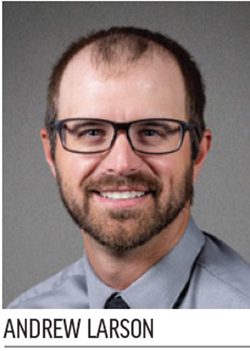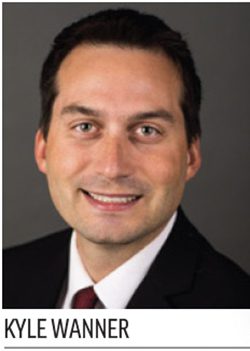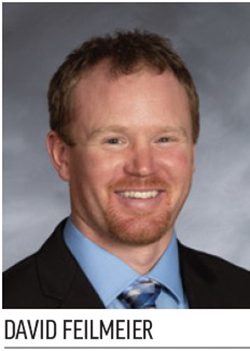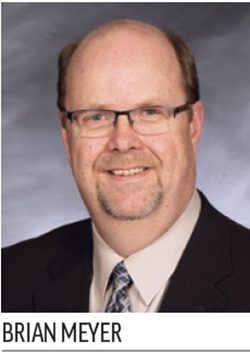The history of airfield pavement is filled with products and technologies originally developed for the road and highway industry. The latest chapter in that story is an asphalt surface treatment that has been successfully applied in more than 20 significant airport projects since 2019, including three general aviation runways completed late last year in Colorado, Minnesota and North Dakota.
The history of airfield pavement is filled with products and technologies originally developed for the road and highway industry. The latest chapter in that story is an asphalt surface treatment that has been successfully applied in more than 20 significant airport projects since 2019, including three general aviation runways completed late last year in Colorado, Minnesota and North Dakota. Based on the positive outcomes, even more applications are planned for 2024 and 2025 across the U.S.
P608H asphalt surface treatment is designed to mitigate raveling and weathering distress on structurally sound runways that are not typically candidates for seal coating or surface treatments currently specified by the FAA. It is a thicker, heavier product than standard P608 (the H in its name is for “heavier”) that can extend the service life of airfield pavement four to eight years—possibly seven to 10 years under ideal conditions.
Development of an original version of the product began in 2015, and the treatment was launched to the road/highway market in 2018; and a subsequent version with smaller fine aggregate and other modifications was introduced to the aviation industry in 2019. Independent third-party subject matter expert engineers helped confirm the safety and effectiveness of the treatment.
|
facts&figures
Project: Asphalt Maintenance Treatment Location: Silver West Airport—Westcliffe, CO Scope: Runway & ramp connector Product Applied: P608H from Asphalt Systems Inc. Cost: $250,000 (including project design & construction management services) Funding: 90% state; 10% local Application: Aug. 29–Sept. 1, 2022 Project Partners: Custer County Board of Commissioners; Colorado Div. of Aeronautics; Armstrong Consultants
Location: LaMoure Rott Municipal in ND Product Applied: P608H from Asphalt Systems Inc. Scope: Runway (3,400 ft. long, 50 ft. wide); adjacent taxiway; about 400 sq. yards of apron Cost: $231,000 Funding: 90% state; 10% local Project Partners: ND Aeronautics Commission; KLJ Engineering; Fahrner Asphalt; Specialty Applicators LLC Application: About 4 hours, on Sept. 9, 2022 Project: Asphalt Maintenance Treatment Location: Rolette Airport in ND Product Applied: P608H from Asphalt Systems Inc. Scope: Runway (3,400 ft. long, 40 ft. wide) Cost: $175,000 Funding: 90% state; 10% local Project Partners: ND Aeronautics Commission; KLJ Engineering; Fahrner Asphalt; Specialty Applicators LLC Application: About 2 hours on Sept. 11, 2022
Location: Luverne Municipal Airport in MN Product Applied: P608H from Asphalt Systems Inc. Scope: Taxiway & apron Cost: $472,000 Funding: 90% Federal; 5% state; 5% local Application: Sept. 10–Nov. 14, 2023 Project Partners: MnDOT Aeronautics Div.; DGR Engineering; Fahrner Asphalt; Specialty Applicators LLC Product Differences: P608H contains 3-4 times more binder residue as standard P608, 5-7 times more friction fine aggregate & more polymer to lock in heavier aggregate load Key Benefits: Extends pavement life 4-8 years, or 7–10+ years under ideal conditions; seals & protects surface/distress cracks; reduces foreign object debris; cures faster than other surface treatments; provides additional durability & protection against oxidizing moisture & UV rays |
Because P608H was only recently submitted to the FAA for consideration, projects using it are not eligible for FAA funding without Modification of Standards approval. Even so, individual airports and state aviation agencies are finding alternative funding and forging ahead with its use after seeing its potential return on investment.
What Makes It Different
While standard P608 surface treatment is an FAA specification (since 2014), it provides limited benefits to severely distressed runways. Personnel from Asphalt Systems Inc. explain that the newer, heavier P608H version seals and protects airfield surfaces with even coverage and also protects the edges and faces of distress cracks, thus minimizing foreign object debris from treated cracks.
When comparing the newer, heavier product to standard P608, they note that P608H has three to four times the amount of binder residue and five to seven times the amount of friction fine aggregate. In addition, it is designed with significantly more polymer to lock in the heavier aggregate, which speeds cure time and provides more durability. The heavy formula also offers more protection against oxidizing moisture and UV rays, they add. P608H treats approximately the top quarter-inch surface of asphalt, so it does not fill cracks deeper than that into the pavement or subgrade.
Like other surface treatments, P608H requires standard preparation, including vacuum truck sweeping, blowing and paint removal. Brian Meyer, aviation services leader with DGR Engineering, says the prep work is similar to what is needed before applying standard P608. “You have to repair cracks and remove any paint markings and clean it,” he says. “It actually goes down reasonably quickly, so the prep work and crack repairs probably take as long as the application.”
Specifically, P608H has application rates of up to 0.26 gallons per square yard, with specified aggregate of 2 to 3.5 pounds per square yard.
The FAA recommends rehabilitation for airfield surfaces with a pavement condition index (PCI) between 55 and 70; however, rehabilitation is sometimes justified outside those parameters. In most states’ DOT Aeronautics programs, a PCI rating below 70 typically initiates an overlay project, replacing the top 1 to 2.5 inches, or a mill-and-fill project, which removes and replaces the top 1.5 (non-structural) to 3.5 inches (structural) of asphalt with new hot mix asphalt at a cost of up to $50 per square yard. Applying P608H can raise a runway’s PCI from a “critical” category to the “pavement maintenance” category or increase the serviceability of the pavement—depending on the amount and severity of cracking, note personnel from Asphalt Systems Inc. At that point, the project can likely qualify for maintenance funding, and the airport is able to extend the life of its runway and delay more costly rehabilitation.
Although the prep work for P608H is very similar to prep for standard P608, it requires more onsite space for materials. “A larger staging and storage area is required because of the need to have a considerably higher quantity of aggregate,” advises Curt Cady, environmental specialist and aviation supervisor with KLJ Engineering.
The application process for P608H is also slightly different. It must be applied with a combination synchronous asphalt distributor and aggregate spreader unit to handle heavier amounts of aggregate, while standard P608 is applied with a distributor truck unit. Locating the specialty equipment needed for P608H requires airports and project teams to plan further ahead, because it may not be available in the immediate area.
Application time between the two products is very similar. “If you’re looking at the exact same project, there’s no difference in timeframe,” says Jared Manning, FAA Northwest Mountain Region lead for Asphalt Systems Inc.
Gregory D. Cline, P.E., an airfield pavement and surface treatment subject matter expert whose clients include Asphalt Services Inc., has observed no surface degradation after almost five years at all 26 of the P608H locations he has assessed thus far. “I am extremely impressed with this product, as is every airfield personnel I have talked to that has had this applied as a demo,” Cline reports. By his estimates, the heavy surface treatment will extend the life of pavement by seven to 10 years, and he predicts that PCI results will remain relatively constant as the product ages (considering past and present pavement distress types and severity, as well as climate and pavement type).

In Cline’s assessment, P608H has exceeded expectations at all project sites. Even in locations with 40 to 50 snow removal events per year, he reports that the treated pavements are showing no surface degradation or delamination. Fuel and oil leaks did not deteriorate the P608H seal either, he adds.
Airports typically without snow—including Buckeye Municipal in Arizona, where P608H was applied last year—can also benefit from the heavy surface treatment.
Before working as a private consultant, Cline was an FAA airport pavement subject matter expert and Naval Facilities Engineering Command subject matter expert for airfield pavements.
Colorado Trailblazers
The Colorado Division of Aeronautics has been one of the first state agencies to try the relatively new treatment strategy. “A big focus of our grant program across the state is pavement maintenance,” says Aeronautics Director Dave Ulane. “Obviously, that’s one of the most important things for airports and certainly a high priority for us.”
 Recently, the agency provided a grant to the Colorado Airport Operators Association for hands-on training about airfield pavement maintenance, and Asphalt Systems’ P608H was among the surface treatments demonstrated. After seeing what the product looked like when applied and learning more about its performance, discussions ensued about logical locations to try it out. The Aeronautics Division was particularly interested because pavement seems to dry out faster in Colorado than in other lower-elevation states. The team also sees P608H as an intriguing cost-effective alternative to traditional P608 for pavements with low PCI ratings. “There’s just not enough money to go around to make sure that the pavement can be rehabbed every 10 years,” says Aeronautics Division Program Manager Todd Green.
Recently, the agency provided a grant to the Colorado Airport Operators Association for hands-on training about airfield pavement maintenance, and Asphalt Systems’ P608H was among the surface treatments demonstrated. After seeing what the product looked like when applied and learning more about its performance, discussions ensued about logical locations to try it out. The Aeronautics Division was particularly interested because pavement seems to dry out faster in Colorado than in other lower-elevation states. The team also sees P608H as an intriguing cost-effective alternative to traditional P608 for pavements with low PCI ratings. “There’s just not enough money to go around to make sure that the pavement can be rehabbed every 10 years,” says Aeronautics Division Program Manager Todd Green.
Silver West Airport (C08) in Westcliffe, CO, emerged as a strategic test site; and crews applied P608H to the entire runway and ramp connector in summer 2022. Total cost was about $250,000, including project design and construction management services. The state paid for 90% of the cost, and local funds covered 10%.
“We’ve seen that it can actually take care of really all low to medium weathering that we were showing through PCI, along with a lot of the low cracking, which is less than a quarter-inch wide,” Green reports. “It was actually sealing most of those cracks as well through the application of this product.”
The treatment appears to be holding up very well after more than a year of aircraft traffic, he adds. “Nearly all of the low cracking that was sealed during the application continues to be sealed, and the friction component continues to be very high through a year of snow plowing operations. Our hope is that we get seven to 10 years out of a product like this.”
 This project did not require a Modification to Standards because Silver West—like many other airports in Colorado—does not qualify for FAA’s National Plan of Integrated Airport Systems (NPIAS) and associated federal grant funding. “There’s just not a lot of local money to go around to do these large $3 million rehabilitation or reconstruction projects,” Ulane remarks. “If we can find some innovative ways to try to make sure those pavements can last as long as they can, we do. So instead of $3 to $5 million projects every 15 to 20 years, maybe we can do those projects maybe every 25 to 30 years.”
This project did not require a Modification to Standards because Silver West—like many other airports in Colorado—does not qualify for FAA’s National Plan of Integrated Airport Systems (NPIAS) and associated federal grant funding. “There’s just not a lot of local money to go around to do these large $3 million rehabilitation or reconstruction projects,” Ulane remarks. “If we can find some innovative ways to try to make sure those pavements can last as long as they can, we do. So instead of $3 to $5 million projects every 15 to 20 years, maybe we can do those projects maybe every 25 to 30 years.”
More recently, P608H was applied to Runway 08-26 at Southeast Colorado Regional Airport (LAA) near Lamar, CO. The project started Oct. 11, 2023, and ended with striping just two days later.
Although the airport itself is federally obligated, the crosswind runway that was treated was not eligible for federal funding and the airport was able to apply P608H without FAA product approval. The pavement had high and medium raveling throughout its surface along with multiple areas of longitudinal and transverse cracking.
“It actually had a PCI of zero, which is very rare for us,” Green shares. Aeronautics Division staff is working with the airport and Asphalt Systems on research to determine whether P608H can hold pavement with this level of degradation together until the local community can decide the future of the runway.
Elsewhere in the state, Astronaut Kent Rominger Airport near Del Norte, CO, plans to apply P608H on a taxiway, most likely this summer.
Midwest Tests
Like the Colorado Division of Aeronautics, the North Dakota Aeronautics Commission had been looking for a solution for airport pavements with significant weathering and raveling. Previous attempts to remedy these issues using seal coat treatments with minimal aggregate content yielded inconsistent results.
 “We’ve had a lot of frustrations with the standard P608 [products] because they just don’t seem to fix any of those issues,” explains Adam Dillin, airport planner for the North Dakota Aeronautics Commission. “We’re experiencing significant deducts when the pavement condition indexes are run every three years, so that’s been really frustrating to us.”
“We’ve had a lot of frustrations with the standard P608 [products] because they just don’t seem to fix any of those issues,” explains Adam Dillin, airport planner for the North Dakota Aeronautics Commission. “We’re experiencing significant deducts when the pavement condition indexes are run every three years, so that’s been really frustrating to us.”
At one airport where standard P608 was used, PCI results returned to approximately the same pre-treatment levels just one year after application.
Executive Director of the Aeronautics Commission Kyle Wanner notes that asphalt surfaces in North Dakota typically need to be sealed every five to seven years due to the state’s aggregate material, oil types and harsh winters. “So, we are constantly looking for the best treatment options,” Wanner explains. “Heavy or micro surface solutions have become more attractive for pavement surfaces in North Dakota because they provide a better long-term solution for the distress types that we have recently been seeing.”
After local engineers told Aeronautics Commission staff about P608H applications in other states, they connected with Asphalt Systems in spring 2022 for more information. LaMoure Rott Municipal Airport (4F9) and Rolette Airport (2H9) were then selected to test the product that fall, because both airfields were due for treatment due to weather and raveling issues, and neither is eligible for federal funding.
 KLJ Engineering was the engineering consultant and Fahrner Asphalt the prime contractor for both projects. “The application process for the P608H treatment was notably efficient after completing the necessary preliminary work such as pavement marking removal and crack repairs,” says KLJ Project Engineer Andrew Larson.
KLJ Engineering was the engineering consultant and Fahrner Asphalt the prime contractor for both projects. “The application process for the P608H treatment was notably efficient after completing the necessary preliminary work such as pavement marking removal and crack repairs,” says KLJ Project Engineer Andrew Larson.
Crews from Specialty Applicators LLC of St. George, UT, began work on Sept. 9 at Rolette Airport but were delayed by low overnight temperatures. When conditions improved, the team completed the airport’s 3,400-by-40-foot runway within two hours. The team then proceeded to LaMoure Airport, where it treated a 3,400- by-50-foot runway, adjacent taxiway and an apron area of approximately 400 square yards, all within four hours. “The preparation and temperature adjustments accounted for most of the project time, underscoring the speed of the actual application work,” says Cady, from KLJ Engineering.
Quick curing time—one day vs. one week or more for other treatments—is a major advantage, adds Dillin. Closing the runway at LaMoure Airport would be especially problematic for aerial spray operators. “Every day they can’t work, they’re losing money, and that’s impacting farmers,” Dillin explains. “So the less downtime that we can have, the better.”
 On average, P608H material is about twice as expensive as P608 material, largely due to a substantially higher volume of aggregates. However, overall project costs are typically only 25% to 30% higher. “If the end result is a better product, it’s going to last longer and can actually take care of the issues that we’re having with these pavements, that’s a worthwhile investment,” Wanner reasons. “We’re willing to consider higher upfront costs if we’re going to have longer-term benefits.”
On average, P608H material is about twice as expensive as P608 material, largely due to a substantially higher volume of aggregates. However, overall project costs are typically only 25% to 30% higher. “If the end result is a better product, it’s going to last longer and can actually take care of the issues that we’re having with these pavements, that’s a worthwhile investment,” Wanner reasons. “We’re willing to consider higher upfront costs if we’re going to have longer-term benefits.”
Cost for P608H application was $231,000 at LaMoure and $175,000 at Rolette. Both airports applied for and received state grants that covered 90% of the expense.
Results Now and Later
Before the runway at LaMoure Airport was treated with P608H, it had been about seven years since it was overlaid, and its PCI was 72. The taxiway, on the other hand, was about 23 years old and had a PCI of 40—so essentially at the end of its useable life. Applying the heavy treatment to pavement of different ages and conditions is allowing the North Dakota Aeronautics Commission to assess how the product holds up over time. “This really does look like an option to be that Band-Aid, if you will, to actually help postpone some higher-cost rehabilitations,” Wanner says.
Crews will take new PCI readings in fall 2024, and the team looks forward to higher numbers, indicating big improvements in the pavements.
Wanner and Dillin visited LaMoure Airport in October 2023 to see how the P608H treatment was holding up about one year after application. “The extra heavy material seemed like it did a really good job filling in the weathering that was on the surface and reducing the raveling issues,” Dillin reports. “It didn’t completely fix them, but it did noticeably reduce them. The regular P608 would do very little to any of that, so the heavy treatments seem to be pretty successful in that regard.”
The material also appears to be more resistant to North Dakota’s extreme temperatures, which can range from 105 F in summer to 45 below zero during winter.
Personnel at both North Dakota airports are watching carefully for wear from the blades of snow removal equipment, and P608H is reportedly demonstrating remarkable resilience. Blane Robert, airport manager at LaMoure, says there have been no indications of the treatment peeling or being compromised by equipment despite a severe winter with almost daily plowing.
 P608H may even provide added traction. “The P608H surface treatment offers a texture comparable to that of an asphalt shingle, possibly enhancing skid resistance under wet or icy conditions—a key safety feature for airport operations in North Dakota,” says Cady.
P608H may even provide added traction. “The P608H surface treatment offers a texture comparable to that of an asphalt shingle, possibly enhancing skid resistance under wet or icy conditions—a key safety feature for airport operations in North Dakota,” says Cady.
Based on the results so far, Dillin suspects P608H could last eight to 10 years—about double the expected lifespan of standard P608. “That’s especially valuable when you’re dealing with non-NPIAS airports with very limited funding, and you need to stretch the lifespan of those pavements every bit that you can,” he remarks.
There are three additional non-NPIAS airports in North Dakota hoping for P608H applications in 2024. Engineers are also considering using the heavier alternative on FAA projects for at least one NPIAS airport in the state.
Extra Paperwork
When Luverne Municipal Airport (LYV) in Minnesota was in the design phase for taxiway and apron improvements, onsite evaluations by DGR Engineering and Asphalt Systems Inc. found significant distress that required a more advanced solution than standard seal coats and surface treatments. DGR Engineering had used standard P608 at other airports, but found it could only improve deteriorated pavement to a certain threshold. “We’ve kind of been watching this P608 to see when they might come out with a heavier application,” Meyer says.
 David Feilmeier, a civil technician with DGR Engineering, was lead designer for the project at LYV. “There had been some state-funded projects where [P608H had been] used on airports, but nothing through the FAA,” Feilmeier notes.
David Feilmeier, a civil technician with DGR Engineering, was lead designer for the project at LYV. “There had been some state-funded projects where [P608H had been] used on airports, but nothing through the FAA,” Feilmeier notes.
To use the heavier treatment on the apron, DGR Engineering worked through FAA’s often-lengthy Modification to Standards process. After documenting why an alternate material would be more suitable than standard approved options, the project team submitted its rationale to the FAA Airports District Office. After receiving approval there, it continued up the chain to the Regional Office and finally FAA headquarters in Washington, D.C. Overall, securing approval for a Modification to Standards took about five months.
Crews applied P608H at LYV on Sept. 11 and 12, 2023; and the project concluded with striping Nov. 14, 2023.
Future applications of the treatment are planned for at least one more Minnesota airport in 2024. “There’s a good appetite out in the industry for this, now that it has been used,” Meyer remarks.
Project Challenges

The main challenge at LYV in Minnesota was that P608H was new to all parties involved—from the engineering team and contractors to the FAA and state Aeronautics Division. “We were being careful and cautious in needing to get ourselves up to date on how the application was different than the standard P608,” Meyers recalls. “There’s just a learning curve.”
In North Dakota, finding the proper equipment and expertise proved to be the main challenge. “I believe there’s only four contractors in this part of the country that have that particular vehicle,” shares Dillin. “The nearest one is Minnesota, the next one after that is Wisconsin; so there’s a bit of a haul for those contractors to get to North Dakota to do that work.”
Wanner consequently advises airports in a given area to coordinate the timing of bidding their projects. “If the same contractor is able to come into the state, they would hopefully get through multiple treatments at once, which would save costs both to them and to the airport sponsors,” he explains.
Cady notes it is critical to consider existing pavement conditions when applying P608H or any other surface treatment. For instance, one previously resurfaced section of LaMoure’s apron had what appeared to be a heavy coal tar-based asphalt treatment; so the contractor did not apply P608H to that area, due to concerns about proper penetration and binding with the asphalt.

What to Know
Meyer, of DGR Engineering, notes that P608H costs just a fraction of significant rehabilitation or reconstruction and is a good option for airports with limited access to federal funds. “I think this will really take off in rural areas and at smaller airports,” he says. “It’s just a good economical tool for the tool bag.”
As an airport planner with the North Dakota Aeronautics Commission, Dillin is similarly intrigued by the cost implications. “It could be very valuable for many, many states and many airports to consider when they’re trying to get the most out of their pavements,” he says.
 Greg Fuller, FAA Central and Southwest Region lead at Asphalt Systems Inc., considers P608H a huge opportunity to help airports with their distressed pavements. “For example, one airport manager and onsite engineer, upon seeing the treatment, wanted to get more funding ASAP to apply it on more pavements across their airport,” he says. “Part of that was a testament to the robustness of the treatment, and part was due to the level of preparation and the quality of workmanship and execution delivered by the contractors who applied the treatments.”
Greg Fuller, FAA Central and Southwest Region lead at Asphalt Systems Inc., considers P608H a huge opportunity to help airports with their distressed pavements. “For example, one airport manager and onsite engineer, upon seeing the treatment, wanted to get more funding ASAP to apply it on more pavements across their airport,” he says. “Part of that was a testament to the robustness of the treatment, and part was due to the level of preparation and the quality of workmanship and execution delivered by the contractors who applied the treatments.”
 Manning, also from Asphalt Systems, points out that before P608H, airports with medium to high, or even severe, surface distresses were forced into costly rehab projects, often on short notice. “That can be challenging, given the timing and complexity of securing the needed funding, airfield closures and downtime and other inconveniences and negative impacts,” he commiserates.
Manning, also from Asphalt Systems, points out that before P608H, airports with medium to high, or even severe, surface distresses were forced into costly rehab projects, often on short notice. “That can be challenging, given the timing and complexity of securing the needed funding, airfield closures and downtime and other inconveniences and negative impacts,” he commiserates.
Green sees potential for it to help Colorado and other states stretch their limited funds. “For some pavements that don’t get a lot of love very often, we can put something like this on and still maintain those throughout the state and hopefully throughout the country,” he remarks.
Cline, a former FAA pavement subject matter expert now consulting in a similar capacity for Asphalt Systems, advises airports to add P608H to their maintenance plans regularly, every six, eight or more years, to extend pavement life. “If you do it at the right frequencies, you can keep your pavements, especially low- and medium-level runways, basically forever as long as you don’t overload them with tons of aircraft over what they’re designed for,” he says. “How it protects the cracks is totally amazing to me—how it protects the edges and faces of distress cracks, thereby preventing foreign object debris.”
Wanner, another voice from the state agency perspective, stresses the need for airports, engineering firms and state aviation agencies to keep abreast of new pavement maintenance options. The precedent of FAA granting a Modification of Standards for P608H also increases his optimism about expanding the pool of airports that can benefit from the heavy treatment.
There’s still a lot to learn about how P608H performs on airfield pavement over the long term. Only time will tell if this is another crossover from the road and highway sector that’s here to stay.






